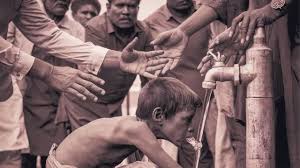From Chamkila’s pop to Arivu’s rap, Dalit resistance gets through music

The ontology of Dalit life and movements has largely been explained and understood more easily in the musicals of vernacular language. One common thread that connects the music of anticaste resistance and transcends the barriers of the language of different regions is the zeal to live a life with freedom with no bounds of caste.
Rehnamol Raveendran
In the recently released film Amar Singh Chamkila (Hindi, 2024), based on the life of an immensely popular, record-breaking Punjabi Dalit singer of the 1980s, the protagonist is seen facing a difficult situation while seeking a proper remuneration for his first record. The manager, in response to Chamkila’s demand runs him down and threatens, saying he could finish off the singer’s career as he is the boss, and eventually throws him out.
Diljit Dosanjh, the Punjabi singer and actor playing the role of Chamkila, replies to the manager saying he is discriminated against because he is a Dalit and further expresses his resilience by stating, “Chamar hu, bhooka nahi marunga” (I am a Dalit, I will never die hungry). Later on, Chamkila creates his own label, never looks back, and becomes the most popular singer ever in Punjab.
Chamkila was born as Dhani Ram in a Dalit Sikh family, became popular with his rustic slapstick village romance songs, hotselling cassettes and LPs, and held more than 360 staged music programs in a year. As militancy rose in Punjab, Chamkila was warned not to sing his popular songs. He then shifted to religious songs and released an album on Dalit Saint Ravidas with hits like Tar Gayi Ravidas Di Pathri. But Chamkila’s popularity never went down, and militants killed him in 1988 when he was just twenty-seven years old.
Chamkila was the first Dalit singer to hit unprecedented heights in pop music in India and internationally. After his assassination, no Dalit in Punjab could reach his popularity. But Dalit resistance began finding its reflection through Punjabi pop music. Punjabi music was otherwise dominated by Jatt singers and was hugely adapted by Bollywood. As an exception, Seventeen-year-old Ginni Mahi stormed the scene like Chamkila, with her Danger (Dangerous Dalit) song in 2016, followed by her other hits like Fan Baba Sahib Di (2016) and Bolo Jai Bhim (2020). She sends Dalits into raptures in her public performances and is immensely in demand.
Dalit resistance in Punjabi music is patterned by invoking Ambedkar, Saint Ravidas, Saint Valmiki, and caste assertion. Chamar pop, as it came to be known, was a form of caste assertion in response to the Punjabi songs that were full of aggrandisation of the Jatt community showing off vehicles and
women. Dalit singer Roop Lal Dhir’s hugely popular album Putt Chamaran Da (Son of a Chamar, 2014) shows the son of a Dalit driving a Hummer vehicle and says he is going to become a district collector asserting the reservation given by Dr B R Ambedkar. This was followed by several Dalit singers releasing
songs on Chamar/Dalit assertion, rights granted through the interventions of Ambedkar and equality proposed by Saint Ravidas.
Interestingly, the hugely popular face of Dalit agitational politics, Chandrasekhar Azad, who was identified in 2021 as one of the ‘Times 100 emerging leaders who are shaping the future’, started his movement by asserting Chamar identity with a hoarding outside his village which read “The Great Chamars of Ghadkauli welcome you”. Dalit music, while asserting Dalit valour, often invokes the commitment to Ambedkarite ideology and the Constitution of India.
Beyond Punjab
The instrumentality of music in consolidating Dalit resistance has its manifestations in western and southern parts of India, more specifically in Maharashtra and Tamil Nadu. Known for its radical Dalit literature and Panthers’ movement, Maharashtra assertion for equality as opposed to hierarchical caste structures. Many anti-caste cultural groups, comprising young artists and musicians, including Yalgaar Sanskrutik Manch and Samata Kala Manch write and compose music as a form of protest against employs folk music as a means to revolt against injustices. Jalsa can be succinctly put as a culture of music against caste. While reflecting upon the ‘everyday social’ and lived experience of caste oppression, Jalsa, exposes power hierarchies of caste and creates consciousness against it among the common mass.
In another instance, Marathi Bhim Geet is the song and music tradition of the Mahar community, with a long list of successful, mostly rendering songs in praise of Ambedkar’s contribution. Civil servants Harshadeep Kamble and Rajesh Dhabre played a major role in bringing bollywood singers and musicians into Ambedkar’s song festivals, and invariably Bhim Geet music became an essential part of all Dalit and Ambedkarite gatherings and celebrations. Apart from the individual popular singers, ‘Dhamma Wings’ is a music band that hit the music scene from Maharashtra in 2015 with Jay Bhim se…the song of pride.
Tamil Dalit music has entered the rapper space in the last decade, and its identity and assertion essentially owe it to brilliant Dalit director Pa.Ranjit. He created the music band ‘Casteless Collective’ in 2017 and introduced the hugely popular singer Arivu, who developed into a rapper, songwriter, and playback singer. Arivu’s song on Ambedkar. Jaibhim Thalaimurai was released as the anthem song for Arakkonam
Bhoomi Festival in 2020, produced by Pa.Ranjit’s Neelam Cultural Centre. His recent release titled Feel like a Panther was on Ambedkar’s birth anniversary. Arivu also wrote and sang Onruser- Ambedkar Statue (2019).
Dalit music has become a popular platform that has connected the people at the grassroots and empowered them to emerge as self-esteemed individuals. Moreover, music has become an essential anti-caste epistemology in academia and research. The ontology of Dalit life and movements has largely been explained and understood more easily in the musicals of vernacular language. One common thread that connects the music of anticaste resistance and transcends the barriers of the language of different regions is the zeal to live a life with freedom with no bounds of caste.
(Author teaches Political Science at University of Allahabad)
Courtesy : DH
Note: This news is originally published in deccanherald.com and was used solely for non-profit/non-commercial purposes exclusively for Human Rights.






